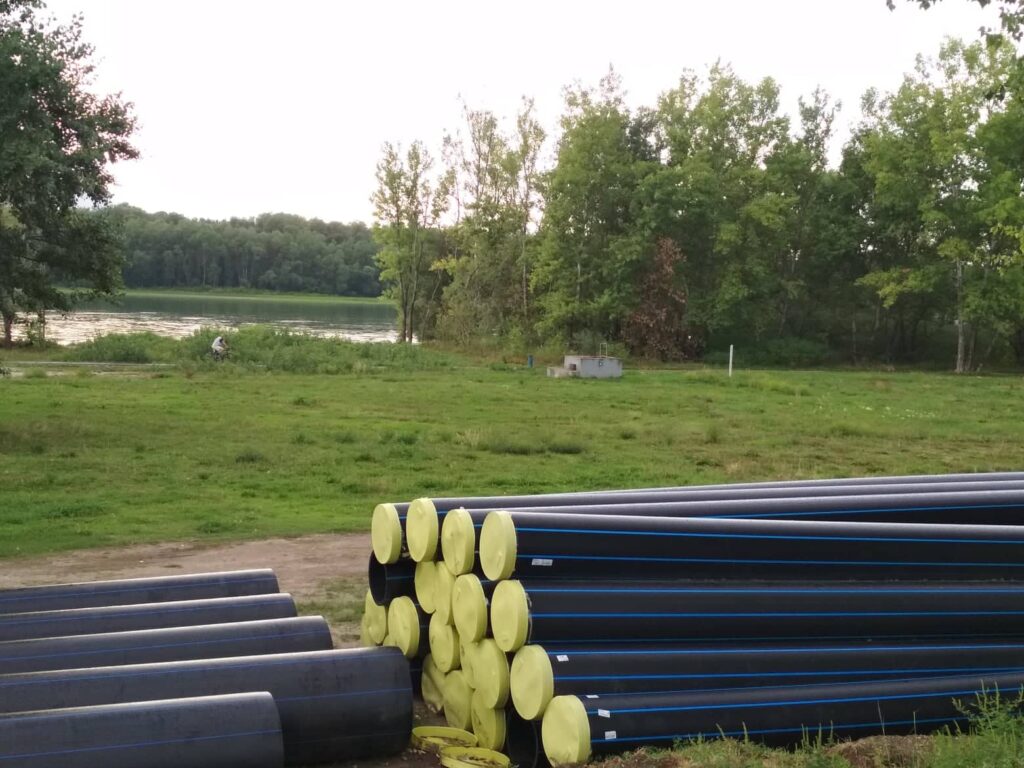The https://english.atlatszo.hu use cookies to track and profile customers such as action tags and pixel tracking on our website to assist our marketing. On our website we use technical, analytical, marketing and preference cookies. These are necessary for our site to work properly and to give us inforamation about how our site is used. See Cookies Policy
Samsung’s battery factory in Göd uses as much water as a city of 100,000 inhabitants
27,000 cubic metres of industrial and drinking water per day will be supplied to the Göd Special Economic Zone via new pipelines. This is enough to meet the domestic and industrial water needs of a city the size of Kecskemét, with a population of around 110 000. The HUF 32 billion (€78 million) investment is being carried out by Mészáros & Mészáros Kft, and the pipeline route, which also affects Natura 2000 protected sites, will require the relocation of protected plants. In addition to the Samsung factory in Göd, other battery factories in the country also have huge water needs. However, it is not clear from the official data provided why the battery factory in Debrecen, which is planned to have twice the capacity of the Göd plant, is forecasted to consume much less water than the Göd plant.
A total of 27,000 cubic metres of industrial water and drinking water will be piped to Samsung’s battery factory every day, according to a notice from the Pest County Government Office. The peak industrial consumption will be 2400 cubic metres per hour. The new pipelines will run for 18 kilometres through the municipalities of Göd, Sződliget and Vác.

This is more than the daily water demand of a city of 100,000 inhabitants. In the city of Kecskemét, for example, with a population of 112,000, the combined water demand of the population, industry and public institutions on an average day is 20,000 cubic metres, which can reach 26,000-28,000 cubic metres a day in hot weather, the CEO of Bácsvíz Zrt. said recently.
Wells closed in one of Hungary’s worst environmental disasters to be reopened
To supply the Göd factory with industrial water, the coastal filtration wells of the southern water basin in Vác, which were contaminated and closed 40 years ago, are being renovated. The incineration of hazardous pharmaceutical waste from the Chinoin factory in Vác caused significant environmental damage to the water base in the late 1970s, contaminating 860,000 cubic metres of groundwater. The incident is considered one of the worst environmental disasters in Hungary. However, no authority has so far been willing to provide information on the full remediation of the aquifer.
Several people, including the mayor of Sződliget, have expressed concern at the prospect of reopening the wells. However, according to the Danube Regional Waterworks (DMRV), there is no reason for concern: “The water quality of the wells – except for nitrogen forms – meets the requirements for drinking water (Government Decree 201/2001 (X.25.)),” reads the statement on the Göd project.
According to the permit issued, the water from the wells must be tested for “general water quality components”. However, experts Atlatszo consulted say that
the tests should also be extended to include substances that seriously contaminated the aquifer 40 years ago.

New pipelines for the wells supplying 24 thousand cubic metres of industrial water per day for the Göd industrial park will be laid in the area of the Vác South waterworks, on the bank of the Danube at Sződliget (photo: Atlatszo)
The water company’s brochure also reveals that the additional 3 000 cubic metres of drinking water per day required by Samsung will be supplied not by these old wells but by a new surface water intake. According to the communication, the supply of drinking water to the public will be completely separate and the drinking water of the inhabitants of Göd will not be mixed with water destined for the industrial area.
Forests and Natura 2000 protected sites will also be affected
The location of the sewer system for the Samsung factory has been modified several times, due to the redesign of the sewer line. Some of the residents of Göd, as well as the municipalities of Sződliget and Vác, have protested against the drainage of wastewater in residential areas. During this years election campaign, Bence Tuzson, Member of Parliament (Fidesz-KDNP), “listening to the voice of the people”, promised that the location of the sewerage system would be changed and that it would avoid some residential areas.
However, the modified route will also mean that forests and Natura 2000 protected sites will be disturbed: the pipeline will cross three forest areas and 1.5 km of nature reserves. According to the Preliminary Assessment Document, 437 specimens of the highly protected sand cockle will be relocated as a result.

The transmission lines will cross a Natura 2000 site, relocating 437 specimens of the highly protected sand cockatoo (source: Wikipedia)
In 2020, the government earmarked HUF 12 billion for the Samsung factory’s waterworks, and this was increased to HUF 32 billion a year later, but this amount is expected to increase further. The pipeline, which will bypass residential areas, will not only be longer than originally planned, but will also require the purchase or expropriation of many privately owned properties, which will certainly benefit Bence Tuzson’s former law firm, Biczi and Turi Law Office, which is handling the land sales and expropriations related to the Samsung investment. According to the responses to our requests for information, the law firm has so far received HUF 2 million from the county municipality and HUF 78 million from the Göd municipality.
Battery factory in Göd uses more water than the larger factory planned for Debrecen
In addition to the Samsung factory in Göd, the Komárom and Iváncsa factories of SK Innovation in South Korea will also receive the water they need for battery production from the river Danube. A few weeks ago the Debrecen battery factory and its water needs, announced as the “biggest greenfield investment” ever in Hungary, came under the spotlight. In Debrecen, China’s Contemporary Amperex Technology Co. Limited (CATL) is planning to build a 221-hectare, 100 gigawatt-hour capacity factory in Debrecen with a budget of €7.34 billion.
Telex.hu reported that László Palkovics said at a hearing before the economic committee before his appointment as head of the Ministry of Technology and Industry that a 100-gigawatt battery factory would require 800 megawatts of energy and 1,000 cubic metres of water per hour. “The question is how we can reduce these levels,” the future minister added.
Following the announcement, a heated debate about the ability to meet the water needs of the industrial park and the CATL factory broke out at the Debrecen municipality’s general assembly on 18 August, Debreciner.hu reported. At the assembly, Mayor László Papp (Fidesz-KDNP) responded to opposition members’ speeches by saying that groundwater and water from the Eastern Main Canal will be sufficient for both the population and industry. The mayor also refuted opinions that the Civaqua programme, which would bring the water of the Tisza to Debrecen via the Eastern Main Canal, was not really being implemented because of the Nagyerdő and the Erdőspuszta lakes, but because of the battery factories.
Ferenc Gorján, CEO of the Debrecen Waterworks, speaking to the dehir.hu news portal, was quick to say that “Debrecen’s water supply is more than enough, even if the water demand of the Chinese battery factory announced last week reaches 1,000 cubic metres per hour”.
Either Minister Palkovics has “underestimated” the water demand of the Debrecen plant, which is claimed to have the highest capacity (100 gigawatt-hours require 1000 cubic metres per hour), or the Göd gigaproject, which will require 2400 cubic metres per hour, will have a much higher capacity than the 40 gigawatt-hours estimated earlier. In any case, it is not clear why the Debrecen battery plant, which has twice the capacity of the Göd plant, would need much less water than the Göd plant.
But the real question is: is it really worth Hungary’s while to have its domestic water resources exploited to such an extent by Far Eastern multinational companies?
While meeting the huge water demand of the battery factory in Göd is a priority for the Hungarian government, this summer the water supply to the population of several municipalities in Pest County was disrupted, and the DMRV waterworks imposed a second-level water restriction.
In addition to the drought, the deplorable state of the water utility system is unfortunately also contributing to the problems of supplying water to the population. This is illustrated by a recent study commissioned by the Water Coalition, a coalition of NGOs and trade unions.
According to the study, the average failure rate on water pipelines in Hungary in 2020 was 1.16 per km. The number of failures – mainly pipe bursts – was even higher, at 2.27 per kilometre, on pipelines operated by the Danube Regional Waterworks Ltd. And based on the pace of renovation work carried out so far, it would take DMRV 165 years to replace and renovate its pipelines. While the residential water network is slowly being torn to shreds, the Hungarian state is spending HUF 32 billion to build a new water supply system for the Samsung factory in South Korea.
State agencies hide monitoring data gathered on groundwater in Hungary
The fact that nothing is known about the state of groundwater is a sad example of the deplorable state of environmental protection in Hungary. Yet on this year’s World Water Day, the UN has set itself the goal of “Groundwater – making the invisible visible”.
Written and translated by Zsuzsa Bodnár. The original, Hungarian version of this story can be found here. Cover photo: the pipes of the pipeline supplying water to the Samsung factory in Göd on the bank of the Danube at Sződliget (Zsuzsa Bodnár/atlatszo.hu)

